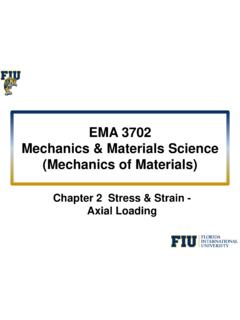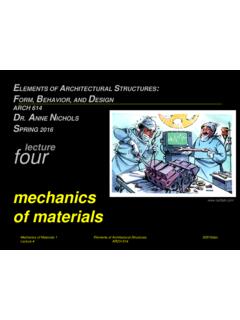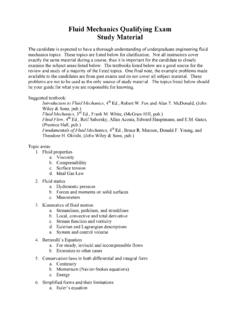Transcription of EMA 3702 Mechanics & Materials Science (Mechanics of ...
1 EMA 3702 Mechanics & Materials Science ( Mechanics of Materials ) Chapter 2 Stress & Strain - Axial Loading EMA 3702 Mechanics & Materials Science Zhe Cheng (2018) 2 Stress & Strain - Axial Loading Statics vs. Mechanics of Materials Statics - Deals with un-deformable bodies (rigid bodies) Mechanics of Materials - Deals with practical, deformable bodies Need to calculate the stress and deformation (relative and absolute) of a body under various loading (stress) states Compute forces and related information (stress/strain) for certain statically indeterminate problems EMA 3702 Mechanics & Materials Science Zhe Cheng (2018) 2 Stress & Strain - Axial Loading Review/Class Exercise Write down equations that define normal stress and shearing stress and write down the names for the terms used and their units Normal Strain under Axial Loading Unit for strain : dimensionless or unitless Sometimes, people write unit such as mm/mm, in/in, or similar How to measure deformation?
2 Example: 2 components, same Materials , same axial load, same cross-section, but different initial length of L vs. 2L. What about change in length in the two? Observations: Same stress Longer initial length gives larger change in total (or absolute) length Relative change in length or (Normal) Strain stays the same AP L 5 Common engineering questions: Which dimension to use? What material to use? Is the design (dimension and/or material choice) safe? Is the design economical? How much deformation (absolute/relative) would it experience? F F Same material D1 D2 F F Different material D2 D2 Stress & Strain EMA 3702 Mechanics & Materials Science Zhe Cheng (2018) 2 Stress & Strain - Axial Loading Deformation in Component with Variable Cross-section For a component with variable cross-sectional area, local strain may change.
3 The strain at point Q is: Total deformation (or elongation/shrinkage) xxdxd dxdxx 0limTensile Test & Stress-Strain Curve/Diagram Metal Polymer Load-displacement curve F - curve useful for obtaining & comparing Materials mechanical properties Ceramics? Typically NOT by tensile test. Instead, bending/ compression test 0L Stress-Strain curve Engineering Strain Engineering Stress 0AP Stress Strain Curves for Ductile Materials Initial linear/elastic behavior for low stress Afterwards, significant non-linear/plastic deformation before fracture or breakage More predictable showing signs of distress or warning ( , necking) before fracture For most metals and plastics non-linear/plastic EMA 3702 Mechanics & Materials Science Zhe Cheng (2018) 2 Stress & Strain - Axial Loading Brittle Materials Small, if any, non-linear or plastic deformation before fracture or breakage No obvious visual warning For certain metals, most glass & ceramics, and polymer at very low temperature Ductile vs.
4 Brittle Fracture (or Failure) Ductile fracture Shearing cone Significant local narrowing or necking Brittle failure Planar fracture cross-section NO obvious local narrowing or necking Elastic Deformation & Hooke s Law Elastic deformation When stress level is low, deformation will be reversible or elastic Elastic Modulus E & Hooke s Law For elastic deformation ( , low stress), in most cases, there is a linear relationship between normal stress and normal strain The slope E for the linear section is called Modulus of Elasticity or Elastic Modulus or Young s Modulus sectionlinear for Slope EU E E Elastic deformation Plastic Deformation & Yield Strength Plastic deformation When stress increases further (beyond elastic region), for many Materials (metals, polymers), deformation becomes irreversible, characterized by non-linear - relationship Yield strength Y The stress level when permanent or plastic deformation starts to occur (or the transition point between elastic & plastic deformation) Often use the value for offset yield strength corresponding to of strain (at point Y), as illustrated.
5 Sectionlinear for Slope EU Plastic deformation Ultimate Tensile Strength & Necking Ultimate (tensile) strength U or TS Highest stress level after which failure will occur sectionlinear for Slope EU Necking Localized deformation as neck in tensile test beyond which absolute load (force) required to further deform it starts to decrease Often occur soon after stress reaching U Ductility: Elongation & Reduction in Area %Elongation (EL) Normal strain (relative increase in length) when fracture happens, which is a measure of how ductile a material is. Often given by EU B 100%00 LLLELB Reduction in area (RA) Reduction in cross-section area when fracture happens, which is another measure of how ductile a material is 10000 LAARABA dditional Concepts and Terminology Toughness Energy absorbed before fracture - The area under the - curve Proportional Limit The limit, often in terms of stress, for linear region in the - curve EU U Proportional limit True Stress and True Strain Engineering Stress = P/Ao True Stress = P/A Ao = original area A = instantaneous area Engineering Strain True Strain Lo = original length L = instantaneous length Experiences tell us material cross-section area changes when load is applied.
6 For stress, which exact area A should we use? AP Engineering stress & strain way more commonly used than true stress & strain 0L )/(LLt 0ln0 LLLdLLLt EMA 3702 Mechanics & Materials Science Zhe Cheng (2018) 2 Stress & Strain - Axial Loading Relationship between Engineering - and True - curves In true - curve, no decrease in stress when necking occurs Engineering - curve easier to obtain & used more widely EMA 3702 Mechanics & Materials Science Zhe Cheng (2018) 2 Stress & Strain - Axial Loading Class Exercise For the - curves of different iron and steel alloys from pure iron to A36, A992, A709, how do the following change? Elastic modulus E No change (in the slope of initial linear section) Yield strength Y Increase (in the transition stress between elastic and plastic regions) Ultimate strength U Increase (in the highest stress it can sustain before fracture) Elongation EL at fracture Decrease (in total strain before fracture) Repeated Loading Unloading - Hardening If stress increases beyond Y, after unloading, and if load again, yielding appears at a higher stress level due to (strain) hardening Load until small plastic deformation (beyond B to C) and then unload When reload.
7 Yielding ( , transition from linear/elastic to non-linear/ plastic) appears at stress level of ~C instead of B Repeated Loading Unloading - Fatigue With repeated loading & unloading, but to stress level much lower than y, failure (sudden fracture) may still eventually happen after many cycles Endurance Limit: Stress level below which fatigue failure will never occur or the part could be cycled indefinitely - n curve ( , stress level vs cycle life) Deformations under Axial Loading (1) For a homogeneous rod with cross-section area A and length L subject to axial tensile load of P. If within elastic limit (or proportional limit), determine the total change in length if the elastic modulus is E Total change in length for the rod L Hooke s Law L E LE LEAP/ EAPL EMA 3702 Mechanics & Materials Science Zhe Cheng (2018) 2 Stress & Strain - Axial Loading Class Exercise For tensile engineering stress strain curve for brass, estimate (a) Elastic modulus; (b) Yield strength at offset strain of ; (c) Maximum load on a specimen with square cross-section with edge length of 10 mm.
8 (d) Change in length for a 250 mm sample subject to 345 MPa ~ psiMPaY31035250 UAP Elastic modulus (Offset) Yield strength Max load kNNPambAPUU4545000104501010062620max At 345 MPa, strain Change in length Deformations under Axial Loading (2) For a member with sections of different cross-section area of A1, A2, .. and each section has length of L1, L2, .. subject to different loading of P1, P2, .., if the stress level are all within elastic limit (or proportion limit), the total change in length is: ii iiiiiEALP P An axial load P applied to a member made with homogeneous Materials but with variable cross-section Deformations under Axial Loading (3) dxd LLdxExAPd00)( dxExAP)( EMA 3702 Mechanics & Materials Science Zhe Cheng (2018) 2 Stress & Strain - Axial Loading Class Exercise Under tensile load of 1000N, for a bar-shaped sample with square cross-section and edge length of 1cm, if the bar sample initial length is 50mm, please calculate the change in sample length if the sample material is steel with elastic modulus of 200 GPa.
9 Assuming it is within elastic deformation limit 1 cm 1 cm PamNmNcmNAF72724210/1010100011000 5971051020010 PaPaE mmmmmL AEPL Engineering stress Engineering strain Change in sample length EMA 3702 Mechanics & Materials Science Zhe Cheng (2018) 2 Stress & Strain - Axial Loading Class Exercise A steel bar 100 mm long and having a square cross section 20 mm on an edge is pulled in tension with a load of 80kN, and experiences a change in length of mm. Assuming that the deformation is entirely linear elastic, please calculate the elastic modulus of the steel ) ()1020(101001080 =92932333 = E/LAF 0/ = 20 =bFLElastic modulus E Statically Indeterminate Problems Determinate Problems: Problems that can be solved by Statics: F = 0 and M = 0 & the FBD B. Statically Indeterminate Problems: Problems that cannot be solved by statics alone: The number of unknowns > the number of equations from balance of force and moments Must involve considerations of deformation or strain Example - Statically Indeterminate Problem A tube with a center rod of equal length L is subjected to a total load of P applied by a hard plate as illustrated.
10 If the cross-section area for the center rod and tube is A1 and A2, while the elastic modulus for center rod and tube is E1 and E2. Assuming it is within the proportion limit and NO interaction between the tube and rod, please determine the load borne by the rod and the tube, P1 & P2 respectively. From Statics: balance of force Only one equation for the balance of force along the axis but two variables - PPP21 Statically Indeterminate! Statically, balance of force gives One equation two variables Example - Statically Indeterminate Problem PPP21 Consider geometry: 22221111 EALPEALP Therefore, PEAEAEAP2211111 PEAEAEAP2211222 21 Superposition Method for Solving Statically Indeterminate Problems 1. Designate one support as redundant support 2. Remove the support from the structure & treat it as an unknown load. 3. Superpose the displacement Example (1) For the structure illustrated, determine the reaction at A & B kNRRBA900 Assume RA and RB both up Statically, balance of force can only give Overall change in length for ACB is viewed as superposition of: Deformation for ACB hanging free with external loads (at D and K) from A with loads at D and K Deformation for ACB due to reaction RB Example (2) To determine deformation for ACB hanging free from A with loads at D and K, divide ACB into 4 parts Part 1: No force or P1 = 0 Part 2: Tensile force of P2 = 600 kN Part 3: Tensile force of P3 = 600 kN Part 4: Tensile force of P4 = (300+600) = 900 kN m Total elongation if ACB hanging free: To determine deformation due to reaction RB alone, divide ACB into 2 parts Part 1 & 2.










